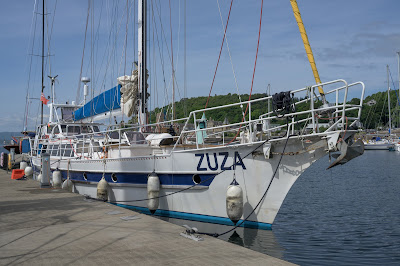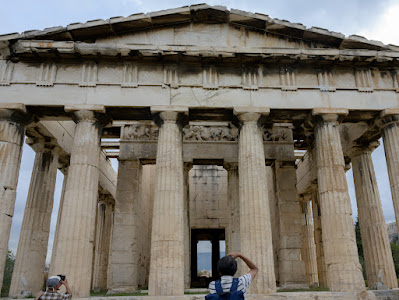3rd May - In Potosi, a Town with a Past
We had arrived in Potosi about 11pm the night before, after a bus journey accompanied by some trashy films and loud music. Our hostel, Koala Den, was a beautiful colonial building with the rooms built around a central courtyard painted in zingy red and orange.
We had a look around the town. Potosi is a fascinating place and a World Heritage Site. It is hard to believe that in the late 16th century it had a bigger population than London did at the time (200,000), in spite being one of the highest cities in the world at 4090m. We were well acclimatised by the time we had reached here, and I don't remember ever feeling the height.
The silver was exported back to Spain by llama and mule to the Pacific coast where it would be shipped to Panama and taken on a mule train across to the Atlantic, and then by boat to Spain. It was also used in the mint that was established in Potosi to forge all the Spanish silver currency.
We did our normal excursion to the main square where the pigeons were again being fed. We had bought some street food and sat on a bench to eat it and take in the vibes.
 |
| Mairi at Koala Den |
Potosi grew rapidly from a small indian settlement to a vast city because of the mountain that overshadows it. Cerro de Potosi or Cerro Rico, Rich Mountain, was the source of most of the silver exported to Spain from their colony in, what was then Peru. The inside of Cerro Rico must look like a Swiss cheese, and indeed the mountain has shrunk by several hundred metres since mining started there.
There is a Spanish saying that something is 'worth a Potosi' meaning it is incredibly valuable.
Legend has it that in 1544 an Inca man called Diego Huellpa stopped on the mountain for the night looking for a lost llama. He lit a fire on the frozen ground and noticed liquid silver running out from underneath it. When news of this reached the newly arrived Spanish it created a silver rush as men were pressed in to service under the Incan mita system where each man was supposed to pay taxes or work for several weeks of the year on public projects. As well as these people there were independent workers and then African slaves, around 30,000 of them were brought in to swell the numbers and replace the dead. The unfortunate native Indians doing their mita were the most expendable as they did the dangerous and labour intensive jobs no one else would touch. In three hundred years nearly 8 million Indians and African slaves died from their work in the mines.
 |
| The Iglesia de San Francisco with Cerro Rico behind it |
The silver was exported back to Spain by llama and mule to the Pacific coast where it would be shipped to Panama and taken on a mule train across to the Atlantic, and then by boat to Spain. It was also used in the mint that was established in Potosi to forge all the Spanish silver currency.
A whole system of reservoirs and conduits were built to power the machinery for the mines, melting the ore and the mint, much of which is still in existence.
The silver boom lasted until around 1800 when reserves of easily mined ore ran out. It is still mined for silver today, as well as other metals.
We walked around the centre of Potosi, looking at the outside of churches. The Iglesia de San Francisco was the first church ever to be built in the colonial period. The Iglesia de San Lorenzo has the most amazing doorway carved in the mestizo-Baroque style by local craftsmen in the 16th century. It is a riot of Inca imagery including mermaids and ladies with strange dresses and bare breasts holding up the columns.
 |
| Iglesia de San Lorenzo |
 |
| Detail |
After lunch the streets were filled with numbers of school children going home. There was also some sort of demonstration of skate boarding around the main square to ask for a skate park to be built in the town.
We thought we would spend the afternoon looking at the Royal Mint or Casa de la Moneda de Bolivia. There was a guided tour in English starting at 2.30 so we made our way down there and waited for the start.
A mint was first established in Potosi in 1572, but was moved in 1757 to its present site. The complex is a large and attractive group of colonial buildings, based around a central open courtyard with balconies above.
Our tour guide definitely wanted us to keep up and seemed to have memorised her script. We started with an exhibition of religious art (nothing to do with the mint) which had been hung in the old meeting rooms. The major work here is a picture of the Virgin cunningly disguised as Cerro Rico. She again has a lot of Incan symbolism incorporated into her, as well as the Spanish king and the pope. I have had to photograph most of the pictures to one side as they were hung opposite doors and windows giving lots of light reflection.
They also hold a number of paintings of the Cusquena school, native artists who had their own take on European religious painting. The figures all seem rather El Greco like and there is a lot of blood.
After this rather fusty display we went to see the actual mint and the machinery which was still in use up until the 1930's. At first the coins were minted using dies and hammers. The machinery was operated by a treadmill which used four ponies to drive it. As the ponies only lasted two months the Spanish replaced them with African slaves. Later they used steam presses. We went in to a cavernous room full of wooden wheels and gears.
The silver mint mark of Potosi is the letters PTSI intertwined and is thought to be the origin of the dollar sign.
There were some interesting windows as we went down the stairs from the machinery room.
We congregated together in an alley between the different buildings before we were led in to a strange museum area. Someone had owned an eclectic collection of stuff, including rocks, fossils and coins. Not knowing what to do with it he donated it to the Royal Mint, I think because they had the room. There was also some ecclesiastical items, connected with silver. The virgin with the silver heart is not in focus. But I quite like it.
Lastly we saw some rooms with the treadmills in, operated by plastic horses, and some rather more modern machinery.
Going out of the mint we saw the official emblem of Potosi, a rather garish green man above the gateway. I think he is supposed to signify 'plenty', although after the boom had finished, this would have meant nothing.
We had booked a tour of one of the mines for tomorrow. This would prove to be a completely remarkable, but for my part, very unrepeatable experience.

































Comments
Post a Comment